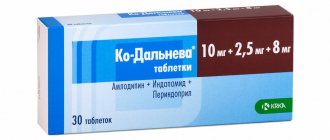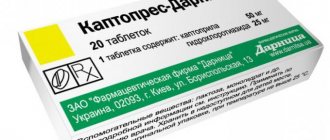brief information
The blood pressure medicine Prestarium belongs to the pharmacological group of antihypertensive medications. The therapeutic effect is achieved due to the ability of the tablets to block the production of angiotensin, which provokes vascular spasms and increased blood pressure. Increases the tone of vascular walls and strengthens them.
Release form
The blood pressure medication Prestarium is available in tablet form. Capsules are convenient for dosing and oral administration. The top of the tablets is covered with a green shell with notches on the sides.
Compound
The main active component of the drug is perindopril arginine. In pharmacy chains you can purchase Prestarium tablets in dosages of 2.5 mg, 5 mg or 10 mg.
The drug also includes auxiliary ingredients: sodium carbonate methyl starch, lactose monohydrate, magnesium stearate and silicon dioxide.
Packaging of Prestarium tablets
Manufacturer
The drug Prestarium is produced in France, by the famous pharmacological company Les Laboratories Servier. Produced and sold in bottles containing 14 or 30 tablets.
Price and terms of sale
The cost of the drug depends on the number of tablets in the bottle and the dosage of the main active ingredient. The average price for Prestarium varies from 320 to 500 rubles. You can purchase the drug in pharmacy chains only upon presentation of an appropriate medical prescription.
Storage conditions
It is recommended to store the drug in a dry place, protected from exposure to ultraviolet radiation, inaccessible to children and pets. The optimal storage temperature is up to +25°C.
Pharmacological action - what pressure does it help with?
Prestarium is an antihypertensive drug. Has the following pharmacological effects:
- Vasodilating effect.
- Antihypertensive properties.
- Decreased blood pressure levels.
- ACE inhibitory effect.
Prestarium helps well against high blood pressure. Improves the general well-being of the patient, has a positive effect on the heart and blood vessels. Prestarium reduces blood pressure within 4-6 hours from the moment of taking the tablets. The therapeutic effect lasts throughout the day, which avoids frequent use of the drug.
Prestarium reduces blood pressure by expanding the lumen of blood vessels
How does Prestarium work?
The drug reduces the production of the hormone aldosterone, the breakdown of bradykinin and renin activity. The decrease in blood pressure as a result of taking it is not accompanied by a disturbance in heart rate. The use of Prestarium has a beneficial effect on renal blood flow. In this case, the main functions of the organs are not affected. During treatment, the size of the enlarged left ventricle is normalized, and the elasticity of the coronary and other large vessels improves. Prestarium containing amlodipine has a complex effect:
- dilates blood vessels;
- normalizes blood flow in the heart vessels and capillaries;
- reduces the load on the myocardium, improves its blood supply.
The medicine does not affect cholesterol metabolism and does not lead to metabolic disorders. The therapeutic effect develops within 1 hour after taking the tablets. It has a cumulative mechanism of action, the maximum is observed on days 4–5 from the start of the course and persists throughout its entire duration. Metabolites of the drug are excreted in the urine. Its remains do not accumulate inside the body. After withdrawal, patients do not exhibit addiction syndrome.
Who is the drug prescribed to?
The use of Prestarium for blood pressure is recommended for patients with the following clinical indications:
- Arterial hypertension;
- Chronic heart failure;
- Hypertonic disease;
- The presence of a stroke in the patient’s history, in order to prevent a possible relapse of the disease, disturbances in cerebral circulatory processes.
Taking Prestarium tablets is also recommended for people suffering from coronary heart disease to prevent the development of various complications and undesirable consequences of a cardiovascular nature.
Prestarium drug overdose, symptoms and treatment
Symptoms of an overdose of any ACE inhibitors are severe hypotension, circulatory shock, tachycardia, bradycardia, electrolyte imbalance, renal failure, hyperventilation, dizziness, anxiety. In case of overdose, the patient should be hospitalized and under the supervision of a physician. The level of electrolytes and creatinine in the blood plasma should be monitored. Treatment depends on the nature and severity of symptoms. It is necessary to reduce the absorption of the ACE inhibitor by gastric lavage and the administration of enterosorbents. In case of severe arterial hypotension, the patient must be placed in a horizontal position with the head down and the blood volume must be restored by infusion of isotonic sodium chloride solution. If necessary, angiotensin II and/or catecholamines are administered intravenously. In severe cases, temporary implantation of a cardiac pacemaker is indicated. It is necessary to monitor and correct the vital functions of the body. Perindopril can be removed from the body using hemodialysis. The use of high-flow membranes is not recommended.
For whom is it contraindicated?
Prestarium with high blood pressure is characterized by the presence of the following clinical contraindications:
- Lactase enzyme deficiency;
- Hypotonic disease (low blood pressure);
- Individual intolerance and hypersensitivity to the components contained in the tablets;
- Impaired absorption of galactose and glucose in the intestinal cavity;
- The patient is a minor;
- Increased tendency to exhibit allergic reactions;
- Aortic stenosis;
- Narrowing of the renal arteries;
- Renal dysfunction occurring in a chronic form in combination with hyperkalemia;
- Inhibition of the hematopoietic function of the bone marrow;
- Severe form of autoimmune diseases.
It is strictly forbidden to take pills for women expecting the birth of a baby and for mothers during breastfeeding.
With special caution, this medicine is prescribed to lower blood pressure for elderly people, patients with diagnosed diabetes mellitus, coronary insufficiency, and coronary artery disease.
Prestarium®
IHD: reducing the risk of cardiovascular complications in patients who have previously had myocardial infarction and/or coronary revascularization
If unstable angina develops during the first month of therapy with Prestarium®, the benefits and risks should be assessed before continuing therapy.
Arterial hypotension
ACE inhibitors can cause a sharp decrease in blood pressure. Symptomatic arterial hypotension rarely develops in patients without concomitant diseases. The risk of an excessive decrease in blood pressure is increased in patients with reduced blood volume, which can be observed during diuretic therapy, following a strict salt-free diet, hemodialysis, vomiting and diarrhea, as well as in patients with severe arterial hypertension with high plasma renin activity (see sections “Interaction with other drugs” and “Special instructions”).
In most cases, episodes of pronounced decrease in blood pressure are observed in patients with severe chronic heart failure, both in the presence of concomitant renal failure and in its absence. This side effect is most often observed in patients receiving loop diuretics in high doses, as well as in patients with hyponatremia or impaired renal function.
At the beginning of therapy and when increasing the dose of Prestarium®, patients should be under close medical supervision (see sections “Dosage and Administration” and “Side Effects”). A similar approach should be used in patients with angina pectoris and cerebrovascular diseases, in whom severe arterial hypotension can lead to the development of myocardial infarction or cerebrovascular complications.
If there is a significant decrease in blood pressure, the patient should be transferred to the “lying” position on his back with his legs elevated and immediately replenish the blood volume (for example, intravenous infusion of 0.9% sodium chloride solution). Intravenous administration of angiotensin II and/or catecholamines is also possible. A pronounced decrease in blood pressure when taking the drug for the first time is not an obstacle to further use of the drug. After restoration of blood volume and blood pressure, treatment can be continued with careful selection of doses of the drug Prestarium®.
In some patients with chronic heart failure and normal or low blood pressure, Prestarium® may cause an additional decrease in blood pressure. This effect is predictable and does not usually require discontinuation of therapy. If symptoms of a pronounced decrease in blood pressure appear, the dose of the drug should be reduced or discontinued.
Mitral stenosis/aortic stenosis/hypertrophic obstructive cardiomyopathy
Prestarium®, like other ACE inhibitors, should be used with caution in patients with obstruction of the left ventricular outflow tract (aortic stenosis, hypertrophic obstructive cardiomyopathy), as well as in patients with mitral stenosis.
Renal dysfunction
For patients with renal failure (creatinine clearance less than 60 ml/min.), the initial dose of Prestarium® is selected depending on the clearance value (see section “Method of administration and dosage”) and then depending on the therapeutic effect. For such patients, regular monitoring of QC and potassium levels in the blood plasma is necessary (see section “Side Effects”).
Hypotension, which sometimes develops when starting ACE inhibitors in patients with symptomatic chronic heart failure, can lead to deterioration of renal function. Acute renal failure may develop, usually reversible.
In patients with bilateral renal artery stenosis or stenosis of the artery of a single kidney (especially in the presence of renal failure), during therapy with ACE inhibitors, there may be an increase in the concentration of urea and creatinine in the blood plasma, which usually resolves when therapy is discontinued.
The additional presence of renovascular hypertension causes an increased risk of developing severe arterial hypotension and renal failure. Treatment of such patients begins under close medical supervision using low doses of the drug and further adequate selection of doses. Treatment with diuretics should be temporarily discontinued and serum potassium and creatinine levels monitored regularly during the first few weeks of therapy.
In some patients with arterial hypertension, in the presence of previously undetected renal failure, especially with simultaneous use of diuretics, the concentration of urea and creatinine in the blood serum may increase. These changes are usually mild and reversible. In such cases, it may be necessary to discontinue or reduce the dose of Prestarium® and/or diuretic.
Hemodialysis
Several cases of persistent, life-threatening anaphylactic reactions have been reported in patients undergoing hemodialysis using high-flux membranes (eg, AN69®). Prescription of ACE inhibitors should be avoided when using this type of membrane.
Kidney transplantation
There are no data on the use of Prestarium® after kidney transplantation.
Hypersensitivity/angioedema
In patients taking ACE inhibitors, in rare cases, especially during the first few weeks of therapy, angioedema of the face, extremities, lips, tongue, glottis and/or larynx may develop. In rare cases, severe angioedema may occur during prolonged use of an ACE inhibitor. If these symptoms appear, the use of the drug Prestarium® should be stopped immediately, and drugs of another pharmacotherapeutic group should be used as a replacement.
Angioedema, accompanied by swelling of the larynx, can be fatal. Swelling of the tongue, glottis, or larynx can lead to airway obstruction. When it develops, emergency therapy includes, among other prescriptions, immediate subcutaneous administration of a solution of epinephrine (adrenaline) 1:1000 (1 mg/ml) 0.3-0.5 ml or slow intravenous administration (in accordance with the preparation instructions infusion solution) under ECG and blood pressure control. The patient should be hospitalized for treatment and observation for at least 12-24 hours until complete regression of symptoms.
Patients with a history of angioedema not associated with taking ACE inhibitors may have an increased risk of developing it when taking drugs of this group (see section “Contraindications”).
In rare cases, angioedema of the intestine develops during therapy with ACE inhibitors. In this case, patients experience abdominal pain as an isolated symptom or in combination with nausea and vomiting, in some cases without previous angioedema of the face and with normal activity of the C-1 esterase enzyme. The diagnosis is made using computed tomography of the abdominal region, ultrasound, or at the time of surgery. Symptoms disappear after stopping ACE inhibitors. In patients with abdominal pain receiving ACE inhibitors, the possibility of developing angioedema of the intestine must be taken into account when making a differential diagnosis.
Anaphylactic reactions during low-density lipoprotein (LDL) apheresis
In rare cases, life-threatening anaphylactic reactions may occur in patients receiving ACE inhibitors during low-density lipoprotein apheresis with dextran sulfate. To prevent an anaphylactic reaction, ACE inhibitor therapy should be temporarily discontinued before each LDL apheresis procedure using dextran sulfate.
Anaphylactic reactions during desensitization
There are isolated reports of the development of life-threatening anaphylactic reactions in patients receiving ACE inhibitors during desensitizing therapy with bee venom (bees, wasps). ACE inhibitors should be used with caution in patients with a predisposition to allergic reactions undergoing desensitization procedures. The use of ACE inhibitors should be avoided in patients receiving bee venom immunotherapy. However, this reaction can be avoided by temporarily discontinuing the ACE inhibitor before starting the desensitization procedure.
Liver dysfunction
Taking ACE inhibitors is sometimes associated with a syndrome starting with the development of cholestatic jaundice, progressing to fulminant hepatic necrosis, and (sometimes) death. The mechanism of development of this syndrome is unclear. If symptoms of jaundice or increased activity of liver enzymes appear in patients taking ACE inhibitors, drug therapy should be discontinued and appropriate examination should be carried out (see section “Side Effects”).
Neutropenia/agranulocytosis/thrombocytopenia/anemia
During therapy with ACE inhibitors, neutropenia/agranulocytosis, thrombocytopenia and anemia may develop. With normal renal function and the absence of other complications, neutropenia rarely occurs. ACE inhibitors are used only in emergency cases in the presence of systemic vasculitis, immunosuppressive therapy, taking allopurinol or procainamide, as well as when combining all of these factors, especially against the background of previous renal failure. There is a risk of developing severe infectious diseases that are resistant to intensive antibiotic therapy. When carrying out therapy with Prestarium® in patients with the above factors, it is necessary to regularly monitor the leukocyte count.
Ethnic differences
It should be taken into account that patients of the Negroid race have a higher risk of developing angioedema. Like other ACE inhibitors, Prestarium® is less effective in lowering blood pressure in black patients.
This effect may be associated with a pronounced predominance of low-renin status in black patients with arterial hypertension.
Cough
During therapy with an ACE inhibitor, a dry, non-productive cough may occur, which stops after discontinuation of the drug.
Surgery/general anesthesia
The use of ACE inhibitors in patients undergoing surgery under general anesthesia can lead to a significant decrease in blood pressure, especially when using general anesthetic agents that have an antihypertensive effect. Taking Prestarium® should be stopped one day before surgery. If arterial hypotension develops, blood pressure should be maintained by replenishing blood volume.
It is necessary to warn the anesthesiologist that the patient is taking ACE inhibitors.
Hyperkalemia
Hyperkalemia may develop during treatment with ACE inhibitors, especially if the patient has renal and/or heart failure or latent diabetes mellitus. The use of potassium supplements, potassium-sparing diuretics, and other drugs associated with a risk of potassium elevation (eg, heparin) is generally not recommended due to the potential for severe hyperkalemia. If the combined use of these drugs is necessary, then therapy should be accompanied by regular monitoring of potassium levels in the blood serum.
Diabetes
In patients taking oral hypoglycemic agents or insulin, plasma glucose concentrations should be regularly monitored during the first month of therapy with ACE inhibitors (see section “Interaction with other drugs”).
Lithium preparations
The combined use of Prestarium® and lithium preparations is not recommended (see section “Interaction with other drugs”).
Potassium-sparing diuretics, potassium supplements, potassium-containing table salt substitutes and food supplements
Concomitant use with ACE inhibitors is not recommended (see section “Interaction with other drugs”).
How to take for hypertension and other pathologies
Instructions for use of Prestarium recommend using the drug in the morning, before breakfast.
The optimal dosage for blood pressure and arterial hypertension is 5 mg (1 tablet) of the medication once a day. If there is no proper therapeutic result, the daily dose of the drug can be increased by 50% (up to 10 mg, 2 tablets).
For elderly people suffering from hypertension, it is recommended to increase the dosage of the medication gradually. The course begins with 2.5 mg of the drug per day. In the absence of any undesirable reactions, the dose is increased to 1 tablet per day or to 2 (if necessary).
The drug is started with minimal doses
For patients with diagnosed heart failure, it is recommended to begin the treatment course with a minimum dosage of 2.5 mg - half a tablet. After two weeks of therapy, the dose of the medication is doubled.
To prevent recurrent strokes, Prestarium is also taken at 2.5 mg, and after two weeks the daily dosage is increased to 1 tablet.
How long to take Prestarium for blood pressure and other pathologies is decided by a specialist individually, taking into account the diagnosis, age category of the patient, the body’s reaction to the proposed treatment and other features of a particular clinical case.
Side effects of the medicine
Despite the fact that Prestarium lowers blood pressure very effectively, therapy with this drug can cause the following side effects:
- Impaired renal function;
- Skin itching;
- Vertigo;
- Disturbance of sleep and natural biorhythms (insomnia at night and drowsiness during the daytime);
- Dyspnea;
- Dizziness;
- Irregular heart rhythm (arrhythmia);
- Heartburn;
- Nausea and vomiting;
- Cough syndrome;
- Erectile dysfunction in representatives of the stronger half of humanity;
- Excessive decrease in blood pressure readings;
- Increased heart rate;
- Cephalgia;
- Psycho-emotional instability, causeless worry, anxiety, irritability;
- Feeling of tinnitus;
- Decreased visual acuity;
- Stool disorders (constipation or diarrhea);
- Muscle spasms;
- Joint pain.
If you detect any of the above-mentioned adverse reactions, you should definitely consult your doctor. It may be necessary to adjust the dosage of the drug or select a more suitable substitute.
Headache and dizziness may be side effects of taking the medicine
Contraindications
Prestarium is prohibited for use in the following pathologies:
- angioedema;
- intolerance to ACE inhibitors;
- galactosemia.
Breastfeeding and pregnancy at all stages are also reasons to exclude the drug from the treatment regimen. The drug should be used with caution in cases of electrolyte imbalance, after internal organ transplantation, aortic valve stenosis, and systemic connective tissue pathologies. Patients on hemodialysis or taking antidepressants should carefully select the dosage and monitor their well-being. Conditions accompanied by excessive vomiting, diarrhea, dehydration, and renal failure also require special attention.
Pharmacological compatibility
Prestarium in combination with Baclofen greatly reduces blood pressure, which can lead to a hypotensive crisis. A similar effect occurs when the drug is used simultaneously with antidepressants.
The combination of Prestarium with potassium-sparing diuretics increases potassium levels in the blood and can provoke the development of hyperkalemia.
The simultaneous use of the drug with non-steroidal anti-inflammatory drugs suppresses its antihypertensive effect, reducing the effectiveness of the therapeutic course.
The combination of tablets with hypoglycemic drugs threatens to excessively lower the patient’s blood sugar level.









